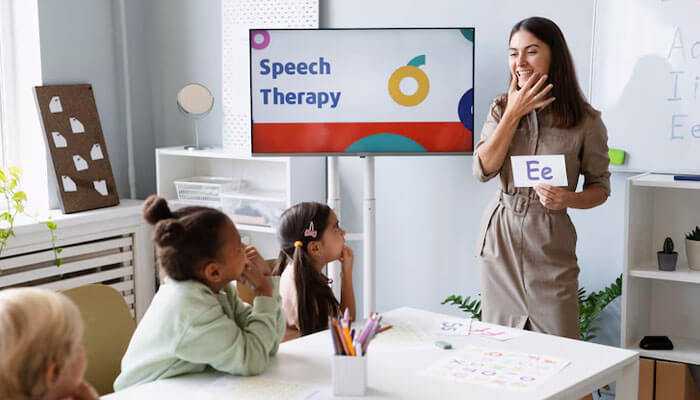Key Takeaways:
1. Empathy and communication: the best speech therapy careers
2. It helps analyze and diagnose speech disorders, formulating treatment approaches for individuals.
3. Especially with those out there with challenges to speech clients everywhere in the world, patience and flexibility are key.
4. There are certain formats and styles that you can use if your focus is on pediatrics (children have such different learning styles!).
5. Various disorders disrupt social ability and emotional connectivity, meaning adult speech therapy cannot afford to not incorporate this depth of work.
6. Teletherapy increases access to therapy by enabling a therapist to reach clients remotely.
7. The use of technology apps and virtual reality makes treatment and client engagement more efficient.
8. Accredited degrees are necessary to expand the horizons of skill development in speech therapy careers.
9. Administrative positions offer some of the first chances to affect health policy and practice in how clients are cared for.
10. Speech therapy research supports evidence-based practices and advances the field.
What Behaviors Enable a Speech Pathologist To Be the Best at Their Job?
Therapy is All About Empathy & Communication
Empathy and communication are at the heart of successful speech therapy careers and are essential qualities for any dedicated speech therapist. Speech therapists don’t merely repair disrupted speech pathways; they first strive to understand their clients on a deeper level—how they feel, what they fear, and the challenges they face. Genuine empathy allows therapists to connect in a way that makes clients feel safe and supported, encouraging them to express what they may have kept locked away. This is particularly vital when working with children who might feel apprehensive about their speech difficulties. Even when full empathy isn’t immediately achievable, honest and warm communication can foster cooperation and engagement, helping the child feel supported rather than judged.
In addition, listening is a crucial component of communication, not just verbal. Apart from verbal communication, subtle body language and facial expressions can play a vital role in making your client feel comfortable and open. In addition to this, therapists should also be skilled at putting misconceptions and ideas in layman’s terms. This is especially important when working with kids, or adults, who may find it hard to understand the complexities of their conditions.
In every scenario, it means the therapist has to be responsive and respond to a system that is in flux with their clients. By focusing on both creating a genuine relationship, as well as conveying information and direction, therapists are able to understand clients in many ways (empathy) at once.
Analytical Thought: Understanding Speech Patterns
Speech therapy careers go beyond ways and means; it needs a lot of analytical skills to diagnose the speech-related issues one will be facing. Every client comes with fresh problems requiring the ability to observe and analyze critically. A therapist needs to understand what is happening with speech disorders, such as stuttering vs. articulation vs. language processing. This ability includes being able to listen for subtle differences a client may say and noticing trends occurring throughout sessions, as well as developing targeted interventions from in-depth assessments.
This analytical element also includes an understanding of broad linguistic theories and aspects of speech science. After all, therapists need to keep on working with new research and data goodness knows how they refine their approaches. Armed with knowledge, professionals can implement evidence-based practices that ensure that their treatment modalities are scientifically sound. Because it is continuously adapting to newer studies and techniques, this field demands continual learning and skill advancement. As a result, effective analytical thinking not only helps practice today but sets the foundation for speech therapy tomorrow.
Adaptability: Dealing Specialised Difficulties
Patient speech therapy is one of the key virtues, not only an attitude towards applying but also a certainty. As speech pathologists, we know our clients, especially children, do not always make linear progress toward their targets. The most experienced therapists are undoubtedly being tested by moments of frustration, setback, and stagnation. Hence, the best speech therapy careers meet these challenges with a level of patience, allowing clients to learn and evolve at their own pace. Realizing that it might take several tries before anyone gets it right cultivates a space of acceptance and learning where people do not feel pressured to get everything perfect the first time around or face the consequences of failure.
Being patient and adapting are two sides of the same coin. That response changes from session to session and often requires different techniques to access as clients change their reaction styles. Flexible therapists are able to shift gears and adjust their approaches in ways that resonate with the client at that point in time. This adaptability becomes indispensable when dealing with various populations, as the needs and preferences, not to mention how one learns, are all so individually unique. Therapists who can adapt their techniques whilst staying calm, supportive, and constant in their presence for clients tend to be more effective in building strong therapeutic relationships with clients that prompt even better treatment outcomes.
Different Types of Speech Therapy Specialties
When Working with Children: Adjusting Techniques for Little Minds
There are definitely pros and cons to working in speech therapy careers with children. Some kids have speech delays caused by developmental problems, physiological needs, or environmental causes. A successful speech therapist who specializes in youngsters uses playful, delightful methods to gain the attention of more youthful patients. They know how to make learning enjoyable and relatable for children, which is a prerequisite for effective learning, by infusing the sessions with games, songs, telling stories, etc.
Therapists in this area should also understand how children develop because, alongside engaging techniques, without knowing these principles, including the stages at which different skills and attitudes develop, it’s hard to know what is dependent on development versus what may be indicative of a more serious problem. Therapists also have to assess developmental milestones and adapt their skills as such. A speech and language therapist needs to decide if the child is just different because of developmental milestones or if there are true defects in speech that need specific treatment. It necessitates a heavy commitment to continuous learning, as best practice evolves in light of findings in childhood psychology and linguistics.
Meeting the Needs of an Expanding Population with Adult Speech Disorders
An aging population means more adults requiring speech therapy. As adults, we may develop speech disorders for various reasons, such as a stroke or other neurological conditions (e.g. טובוטרופית מחלה) or just simply old age. Collaborating with adults requires a deeper awareness of how these conditions affect their social, emotional, and livelihoods. For adult clients, we need to help them read between the lines because their circumstances may vary, like the fear of talking as a result of performance or work anxiety.
In addition, adult speech therapists must use tactics that reestablish useful communication in a manner that is acceptable to their clients’ lifestyles and objectives. This typically means working with clients to identify achievable, valuable goals that match their particular context and desires for life — such as gaining more clarity at work or building better interpersonal relationships. Developmentally appropriate treatment plans that incorporate both evidence-based methods and client-focused strategies guarantee adults can recognize their competencies in order to reclaim role confidence and reconstruct relational language ability.
Speech Services Delivery through Teletherapy: the New Normal
Technology has changed a lot of sectors, and to none, the speech therapy sector is also an exception. Teletherapy or telehealth speech therapy has emerged as a credible option for filling the gap when face-to-face services are disrupted, especially since the onset of COVID-19. This provides a number of benefits; specifically, it creates more accessibility for clients who may struggle with transportation or are located further from the therapist’s office. Also, it opens the door for clients who would not have been able to receive specialized care in their area.
But, there are some bumps to getting and doing teletherapy. They also have to be intelligent with digital media and create the right setting in online therapy sessions, such as tailoring the services to fit online, getting the clients involved, and keeping communication alive without seeing each other face to face. Moreover, the issue of privacy and data security can be dealt with while the concept is being finalized in an online environment. Those speech therapists who do manage to explore and negotiate this rapacious minefield will find themselves at the season’s front line in an evolution of how healthcare is delivered.
Modern Speech Therapy: What Technology Does to Our Practices
New Tools: Apps and Software that are Transforming Treatment
The incorporation of technology into speech therapy has led to thousands of new tools, including many applications for mobile devices and special software to help therapists and clients. Many of these tools operate with reactive exercises for individual disorders, providing clients with the opportunity to practice between sessions. Numerous apps use aspects of gamification, which especially increases client motive in less traditional drills, particularly with young people. Designed with friendliness and ease of use in mind, these digital tools allow clients and their families to access therapy whenever they wish.
Not only this, but multiple such tools provide tracking & reporting capabilities that allow therapists to track their clients’ progress more easily. Therapists can utilize data to make easy adjustments to treatment plans; this means every client is getting a personalized level of care based on their ability to learn and grow. This incorporation of technology not only streamlines the treatment process but encourages its clients to become active participants in their own therapy journey.
Active Therapy Form Using Immersion in Virtual Reality
The continuous advancement of technology has transformed its application in speech therapy, with virtual reality (VR) becoming one of the most interesting innovations. Whenever a client is very shy and can not talk to anyone in person, just give him or her VR as it offers immersive experiences that allow these clients to practice communication skills in simulated environments. In one example, a client might attend an online cocktail party where they can practice starting conversations, making eye contact, and responding to social cues in a safe environment.
Beyond just being engaging, the advantages of VR therapy include research suggesting it might increase retention and help clients reach their goals faster by mitigating anxiety commonly experienced in situ. In addition, therapists can tailor environments to client needs and levels of development, allowing them to foster individualized experiences with regard to their comfort zones or situations they need help with. With improvements in accessibility and cost, therapists will no doubt add this type of technology into their own sessions, making it a standard practice.
TelePractice: Working with Clients Wherever They Are
Telepractice has been a game-changer in extending the reach of speech therapy careers, enabling practitioners to serve clients around the world regardless of distance. This way of working allows existing clients to have continuity and provides access for people who may not otherwise have had the opportunity for therapy. Telepractice can fill the gap in many NHS services or for specific areas of practice, such as where clients live far away, as is often the case with rural placements.
A strength of telepathic is that it maintains the integrity and effectiveness of therapy and adds flexibility to the schedule. The other common adjustment option is tailoring therapy sessions to the busy lifestyle of both the therapist and client, making it easier for individuals to make appointments, which may lead to fewer missed appointments and following treatment plans. Moreover, therapists are able to strengthen their practice strategy by accessing specialists all around the world for consultations or even just building upon their own practices based on the information they obtain from very different insights. Telepractice is everywhere, asking us to reimagine what an entire therapeutic space looks like outside the model of accessibility and utilizing client-centered care.
From Student to Speech Therapy Careers and Progressions
Further Degrees and Certifications: Getting More Knowledge
In order to excel in the field of speech therapy, earning higher degrees and certifications relevant to the profession is always important as they can provide a therapist with much-needed knowledge and skills while also making them more marketable. Although a master of science is the minimal level of education required to be a speech-language pathologist, many professionals will also pursue—Doctor of Philosophy (Ph. Doctorado en Clinica (D.) or Doctor in Clinical SLP. D.) degrees provide opportunities to specialize in a field or pursue an academic and research-based career path.
Speech therapy careers who maintain specialized certifications such as those conferred by the American Speech-Language-Hearing Association (ASHA) in areas like swallowing disorders, fluency disorders, or communication access for people with complex needs can help advance knowledge and improve practice. These credentials add not just credibility and professionalism but also help therapists understand their field in greater depth, giving them the latest research-based practices to rely on. Continual education and striving for excellence are key to optimal service delivery in a rapidly changing environment of speech therapy.
Roles in Administration: Change Leadership Model
Numerous speech therapy careers in establishing administrative positions at healthcare facilities, schools, or private practices. As experienced practitioners move up the career ladder to leadership roles, they have the potential to impact policy and practice within systems and services, as well as advocate on behalf of patients. These jobs frequently demand a combination of clinical knowledge and business acumen as leaders have to find their way through the complicated world of staffing, budget control, and strategy.
Administrative roles may serve functions that include training new hires, managing regulatory compliance, and developing evidence-based protocols to improve care for citizens. This role can be very rewarding, as it allows therapists to advocate for systemic changes that would help large numbers of people get the therapy services they need to thrive. Furthermore, speech therapy careers in administration often offers more opportunities for advancement and job security than other roles in the field, which can make it appealing to many professionals.
Research Involvement: Participation in the Language of Science
If you are committed to serving the academic community, a research career may be an exceptionally rewarding speech therapy careers. Research opportunities provide unchartered territory for clinicians to test paradigms in the speech and language sciences that challenge existing basic science knowledge with a potential translational impact on clinical practices. Research topics might involve testing the effectiveness of novel treatments, probing speech impairment neurobiology, or evaluating how sociocultural variables play a role in communication development.
Research helps develop the body of knowledge in a profession where therapists can become aware of using research in practice, thereby creating a cycle of continuous improvement. Numerous universities and research institutions provide programs to enhance clinician-researcher collaboration that extends closer to the clinical arena. Research will continue to be a pillar of evidence-based practice that challenges us to innovate and improve outcomes for clients as speech therapy careers progress.




